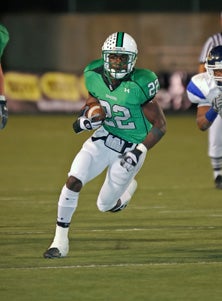Listings of top
2012 high school football recruits are now available and ranking the best teams in the country is right around the goal post.
But grading the progress of high school football's hottest and most important topic – concussion care – is a more difficult and delicate task. More than 60,000 high school football players sustain concussions annually during the season and that can lead to heartbreaking and even tragic events.

Tre Newton, one of finest running backs
in the history of Texas high school
football, quit the game in November due
to excessive concussions. Newton, shown
here as a prep star for Southlake Carroll,
was a sophomore at the University
of Texas when he gave up the game.
File photo by Harvey Dunn
National Federation of State High School Associations (
NFHS) Assistant Director Bob Colgate said he is encouraged how state associations, coaches, educators and legislative leaders have responded to the growing problem of head injuries and how to deal with them.
"But," he warned, "it is always going to be a work in progress."
In an e-mail interview with MaxPreps last week, Colgate, who heads the NFHS's Sports Medicine Advisory Committee (SMAC) said that since June 1, more than 155,000 people have completed the organization's free 20-minute online coach education course: "
Concussion in sports – what you need to know."
The NFHS SMAC acts simply as a resource for all member state associations, which are autonomous and self-governing.
"I think for the most part all of our member state associations have taken a very active role with their member schools in trying to minimize the risk of concussions and also in the management of concussions in all sports that they administer," Colgate said. "There is not a day that goes by that you don't see or hear something in the media about concussions."
Consider the following this month alone:
* A former Highland (Pa.) High School football player
sued the local school district because he claimed he was allowed to play despite sustaining three concussions.
* In the high-profile football state of Texas, the state's governing body for public schools, the University Interscholastic League, mandated that high school athletes who sustained concussions
sit out at least one game and be cleared by a doctor before returning to the field. This "Return to Play" policy is consistent, but a year behind, what most states mandated at the start of the 2010-11 school year.
* Also in Texas, the government got involved and its House of Representatives member approved a measure to
retire football helmets that are older than 16 years and recondition those older than 10 every two seasons.
*
At least 11 states, according to a
PBS.org report, have laws that require education for parents, athletes and coaches about concussion management and protocol. And, according to the
National Conference of State Legislatures, 36 states currently have bills or ones in the works concerning concussions in youth sports.
"A lot of our member state associations have been dealing with new state laws or proposed state laws in their respective states dealing with concussions," Colgate said. "There is a lot of research that is currently being done on concussions at all levels."
The NFHS SMAC met last week, reviewed much of the latest research and will release much of it in its fourth editor of the "Sports Medicine Handbook" in June.
In January, the NFHS SMAC updated its "Suggested Guidelines for Management of Concussions in Sports." It's posted on its website under
Sports Medicine.
Among the more important facts:
* An athlete doesn't need to lose consciousness to have a concussion. Less than 10 percent of players actually do.
* Symptoms include: headache, nausea, dizziness, fuzzy vision, and sensitivity to light or noise, feeling sluggish or foggy, memory problems and/or confusion.
* Signs that are usually observed by parents, friends, teachers or coaches: Forgets plays, unsure of game or score or opponent, moves clumsily, answers questions slowly, personality change, can't recall events prior to hit or events after hit.
* An athlete should never be allowed to resume physical activity following concussion until he or she is symptom free and cleared by healthcare professional.
Not addressed in the guidelines is baseline neurological testing, a relatively expensive procedure that is being pushed in California by Tony Strickland of the Sports Concussion Institute of Los Angeles. He is part of the California Interscholastic Federation's "Play it Safer" campaign.
Strickland is trying to introduce mandatory testing for all high school athletes before they ever participate. That way after a head injury, a second test can be performed to see how the neurons have shifted.
"It makes all the difference in the world," Strickland said. "It's the difference between making an informed decision on returning to action or an uninformed one."
